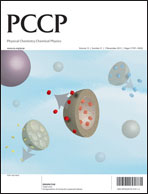The donor/acceptor edge-modification: an effective strategy to modulate the electronic and magnetic behaviors of zigzag silicon carbon nanoribbons†
Abstract
Based on first principles computations, we systematically investigated electronic and magnetic properties of zSiCNRs with unilateral/bilateral modification by employing electron donor/acceptor groups, where five chemical functional groups are sampled, namely, CH3, OH, NH2, CN and NO2. Our computed results reveal that the edge modification with donor/acceptor groups can break the magnetic degeneracy of pristine zSiCNRs, and intriguing antiferromagnetic (AFM) half-metallicity, AFM metallicity and ferromagnetic (FM) metallicity can be achieved. This overcomes the bottleneck that FM metallicity and AFM half-metallicity in pristine zSiCNRs are vulnerable under even small disturbances, due to the energy degeneracy between the FM and AFM states. Obviously, edge modification with donor/acceptor groups can be an effective strategy to modulate the electronic and magnetic behaviors of zSiCNRs, which will be advantageous for promoting SiC-based nanomaterials in the application of spintronics and multifunctional nanodevices in the near future.


 Please wait while we load your content...
Please wait while we load your content...